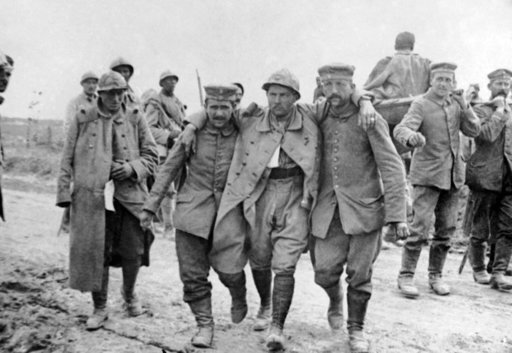COLUMN: July arrives and a terrible anniversary comes round again
Published 7:00 am Tuesday, July 1, 2025

- In this undated file photo, French soldiers carry the wounded during the World War One Battle of the Somme in France in 1916. (AP Photo, File)
The first of July has come round again and the great disaster becomes a trifle dimmer than before.
It is the most dismal of anniversaries.
A testimony to callousness, a tribute to thoughtless slaughter.
The boundaries of this butchery beggar belief.
We might think that today is dangerous as no era before was dangerous, and in one sense this is true.
We have turned the very atom against us, after all.
Yet in the annals of warfare, soldiers rarely have faced a situation as dire as what confronted the tens of thousands fighting in the Somme Valley of Northern France on the morning of the first day of July in 1916.
At 7:30 a.m. the British Army launched its “Big Push,” an offensive, in tandem with the French, intended to crush the German trenches and end the stalemate that had prevailed for nearly two years.
Once the infantry had broken through, the Allied generals proclaimed with pathetic certainty, they would unleash the cavalry to gallop through the breach.
Yes, gallop — this was the First World War and the great armies depended more on hooves than on tires.
The tank, which in future wars would make trench warfare obsolete, would not rumble onto a battlefield until late in that summer of 1916, and on this same Somme battlefield.
The concept sounded simplistic, inexorable.
The Allies had assembled the biggest collection of artillery in the history of war.
Over a week these thousands of guns would fire more than a million shells, a steel rain that would pulverize the German lines, leaving only corpses.
And the inevitable rats, for whom this war was an unprecedented blessing.
In the parlance of the day, it would be a “walkover” for the infantry.
British commanders believed they had conceived the ideal plan for their inexperienced infantry, most of whom had volunteered and had never fought in a major battle.
The soldiers were ordered to stroll across no man’s land, the strip between the labyrinths of trenches. Burdened with 65 pounds or more of equipment, they could hardly move with alacrity.
The generals’ confidence in the power of artillery was misguided.
The blizzard of shells made a terrific noise, to be sure.
And the bombardment blasted fountains of earth from the German lines.
But the Germans had held these trenches for nearly two years. This was quite enough time for the industrious soldiers to excavate bunkers as deep as 40 feet, a task eased by the soft chalk soil that underlies this part of Picardy.
Most of the Germans survived the bombardment.
Yet this didn’t make the carnage inevitable.
In the final accounting, the difference between the typical, albeit terrible, death toll of a major battle on the Western Front, and the worst day in the history of the British Army, before or since, likely was a matter of about five minutes.
That was the interval between the artillery shifting fire to targets behind the front line German trenches, and the infantry “going over the top” — climbing out of their trenches and beginning to trudge across no man’s land.
During that brief span, while the Allied soldiers were smoking a final cigarette or having a gulp of Army ration rum or thinking of wives back home, the Germans clambered from the dugouts where they had endured the bombardment.
Most important, the essential ingredient in the coming catastrophe, the German machine-gunners rushed to their well-protected posts in the parapets of their trenches.
They waited. It didn’t take long.
As they peered through the occasional cloud of smoke from a bursting shell, the gunners saw something that, as some wrote in their diaries, they could scarcely believe.
The Germans knew an infantry attack would follow the bombardment.
But they didn’t expect the British assault to be so leisurely.
The gunners grasped the twin handles of their cunning weapons, based on a design by an American, Hiram Maxim.
The first of hundreds of thousands of bullets began its supersonic flight through the summer air.
The 7.92-mm rounds, spewing at a rate of 500 to 600 per minute, could be lethal at a mile.
But many didn’t travel nearly that far before finding flesh.
The Battle of the Somme continued for more than four months, petering out in the freezing mud of November.
Like so many battles in this most inconclusive of wars, this one had no strategic effect.
The only noteworthy statistics it produced were deaths and wounds.
Its legacy, though, and the reason July 1 remains a milestone in British history more than a century later, was sealed in the first hour or so.
Historians have concluded that most of the British casualties that day happened in that brief period as the sun began to warm the ravaged land.
The day’s final tally has become a sort of terrible talisman, a numerical monument to stupidity and bravery and the insanity that clouds men’s minds during war.
The precise figure can never be known. Not in a battle, and a war, when soldiers sometimes were essentially vaporized by an artillery shell — and old-fashioned version of what a nuclear blast does.
But the generally agreed upon round figures are 20,000 dead and 40,000 more wounded.
The comparisons are awful but irresistible.
That’s more than one-third the number of American soldiers killed during a decade of combat in Vietnam.
It is tempting to ponder such figures and to conclude that society has progressed — that 109 years later we don’t dismiss the value of a human life so blithely as was the case on the Somme.
Perhaps this is so.
It is something, I suppose, that the first day of the Battle of the Somme, even in the wake of the greater bloodletting of World War II, and the coming of the nuclear age, retains much of its palpable horror.
Even in our dangerous age it seems to me uniquely terrible to imagine walking into a literal hail of bullets, as powerless as a butterfly in a hurricane.






